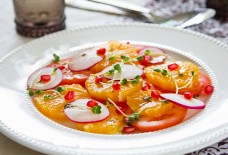Socotra: "The Most Alien Place on Earth"
By Evan Ploeckelman / Arab America Contributing Writer
Socotra, an island off the coast of Yemen, has a reputation as “the most alien place on Earth.” Home to around 700 animal and plant species found only on the island, Socotra is definitely an oddity in the Arab World. While tourism is currently restricted due to the ongoing civil war in Yemen, the island still receives international attention for the unique flora and fauna it houses.
History of Socotra:
The island of Socotra detached from the mainland during the Miocene epoch, or between 5-23 million years ago. As such, the species that live there have developed with little outside influence. Furthermore, the island is difficult to access for most of the year due to seasonal monsoons making the nearby seas perilous. This has led to animal and plant species that look strikingly different from what we are used to.
Plants of Socotra:
The Royal Botanic Garden Edinburgh has confirmed that 307 out of the island’s 825 plant species live only on Socotra. Arguably the most striking of these is the Dragon’s Blood Tree, or Dracaena cinnabari (known in Arabic as dam al-akhwayn, or ‘blood of two brothers’). It has a long trunk and branches, and all of the leaves grow at the end of the branches, giving it an umbrella-like appearance. However, it is most known for its extremely valuable resin known as dragon’s blood. The Arabs, Romans, Persians, Greeks, Indians, and other groups use this substance as a dye and as a medicine. In fact, native Soqotrans still use the dye to treat illnesses such as diarrhea, dysentery, and fevers.
Another endemic species to the island is the Socotran pomegranate, or Punica protopunica. This species is actually the predecessor to all current types of pomegranate that people eat. Unlike those types, however, these pomegranates are not eaten very often as the seeds are very bitter and can cause sores. Ironically, local Socotrans use the skin and seeds in medicine as a cure for sores and wounds.
Many other types of interesting endemic plant species live on Socotra. Dorstenia gigas, for example, is a giant succulent tree that can grow up to 4 feet tall. Many other succulent species have their origins in Socotra.
Socotrine aloe, or Aloe perryi, has well-known medicinal and cosmetic uses for humans.
The Socotrine Cucumber Tree, or Dendrosicyos socotranus, can grow up to 10 feet tall and is actually related to cucumbers, along with melons and gourds.
Animals of Socotra:
Socotra is also home to numerous endemic animal species, although the number is less than that of the endemic plants. There are six endemic bird species, including the Socotra starling, which is distinctive for its light gray head and dark black and brown body. Another bird species, the Socotra sunbird, is known to mimic the cries of other animals. There is one endemic mammal, the bat species Hypsugo lanzai. There are also around 31 endemic reptile species, including skinks, legless lizards, and one species of chameleon, Chamaeleo monachus.
There are also numerous endemic insect and arthropod species. The island is home to three different types of freshwater crabs, which live in the wadis all over the island. The most famous insect on the island is arguably the Blue Baboon Spider, or Monocentropus balfouri. This species is a completely blue tarantula. It also exhibits some characteristics atypical of other tarantula species, such as hostility toward humans and extremely social characteristics between members of the same species. Mothers will even raise and feed their own young, which is unheard of in most other species of tarantulas or spiders.
Current State of Socotra:
The endemic species of Socotra are currently in danger. While the war in Yemen has not affected the seperatist-controlled island all that much, an increase in human activity threatens to destroy some of the species on the island. Human-introduced animals, such as cats, camels, mice, cattle, and others, threaten the species of plants and animals on the island, which have not evolved to deal with these threats. Additional human development, especially due to increased tourism in the last two decades, has also put strain on the ecosystem.
Climate change is also impacting Socotra. Historically, the island was much more tropical and green than it is today. Modern Socotra is relatively arid, especially on the west side, with the exception of wadis on the island. This is dire for all species on the island, as many of them rely on historical levels of water to survive.
Not all hope is lost, however. UNESCO declared the island a World Heritage Site in 2008, which helped to bring attention to the unique flora and fauna of the island. The local government, along with organizations in the UAE, are working to better protect the island for the future. While you cannot visit the island currently due to the ongoing conflict in Yemen, it is important to remember to treat the island with respect if you do get to visit. This will protect the fragile and unique ecosystem of the island for the future.
Check out Arab America’s blog here!









